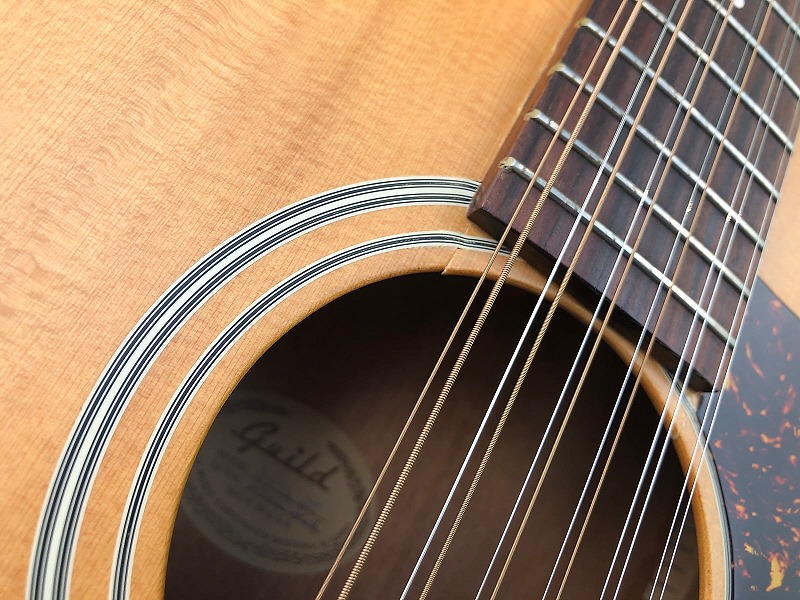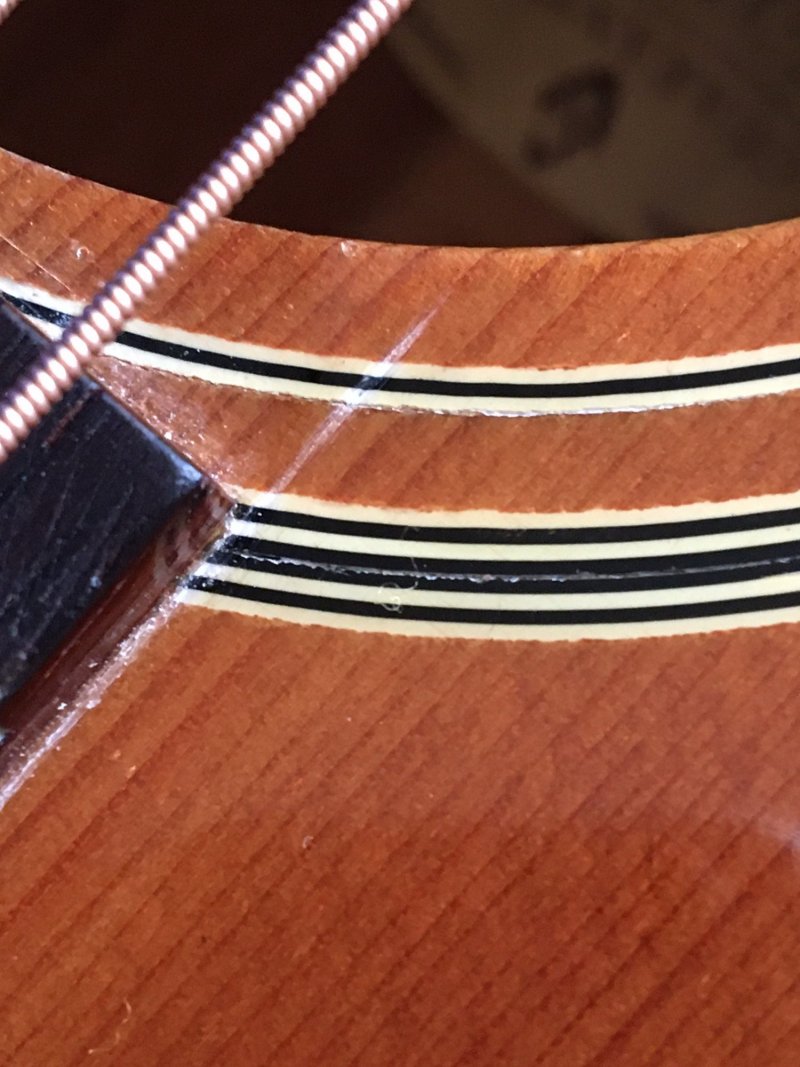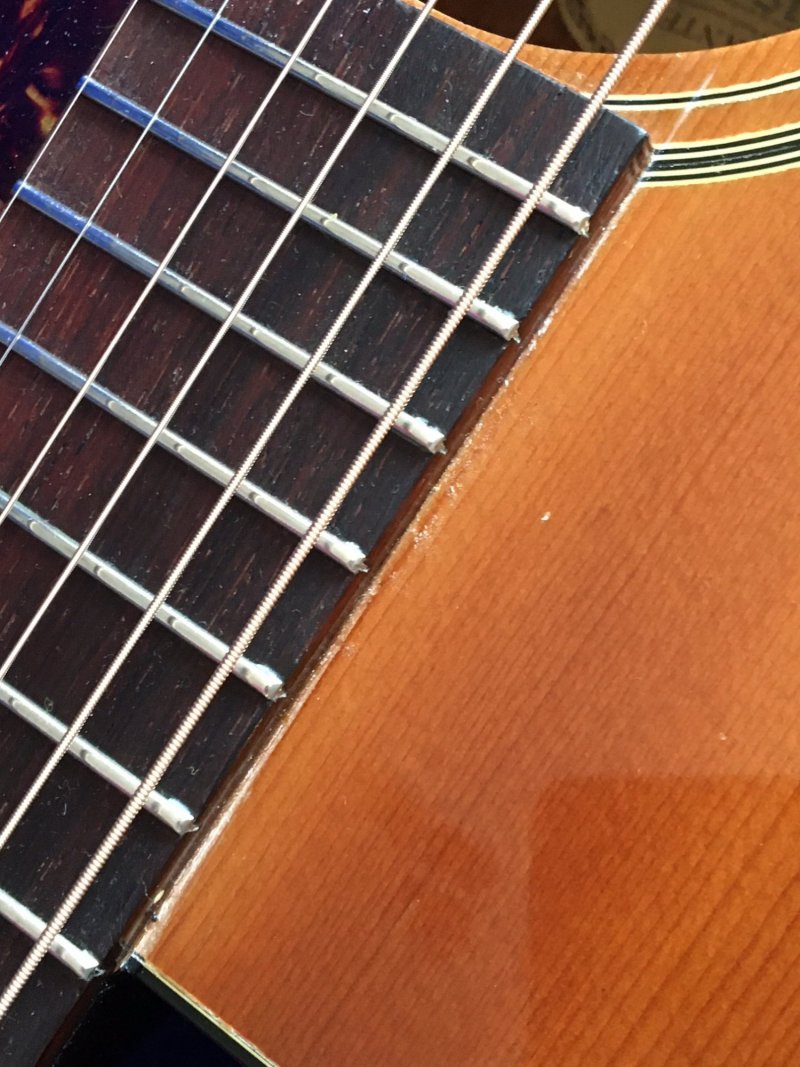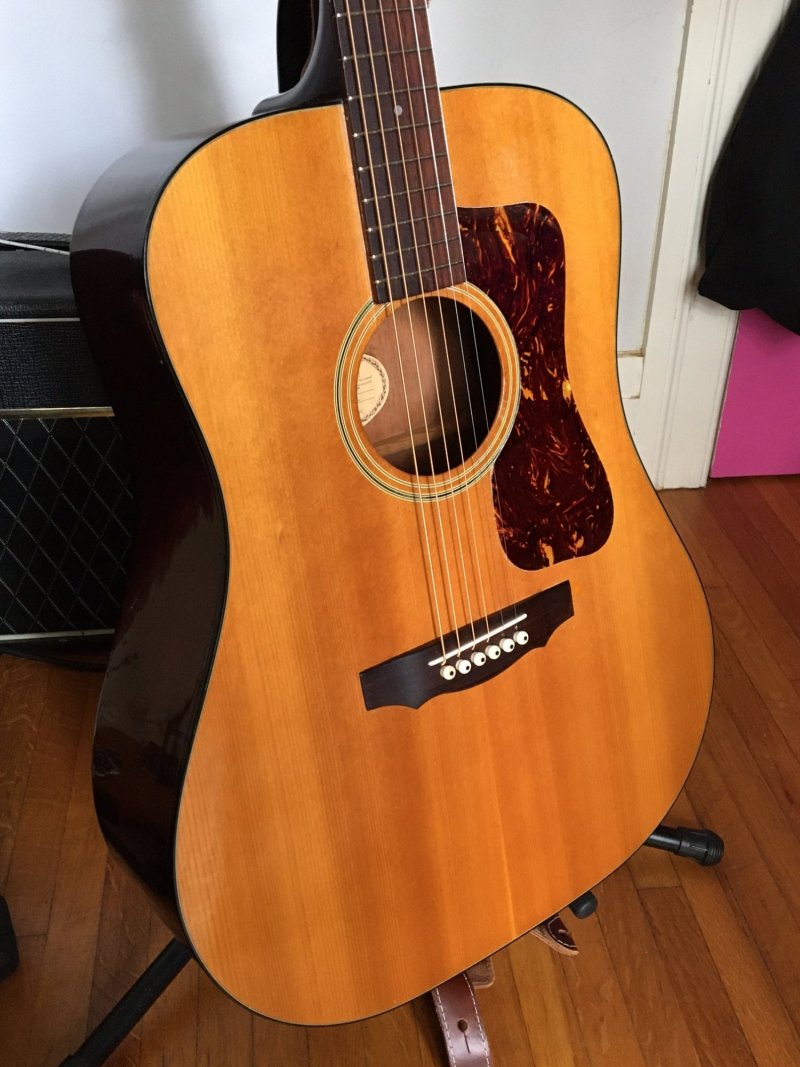You are using an out of date browser. It may not display this or other websites correctly.
You should upgrade or use an alternative browser.
You should upgrade or use an alternative browser.
Neck Block crack appearing on '71 D35
- Thread starter Norrissey
- Start date
SFIV1967
Venerated Member
No real idea, I probably would immediatelly take the strings off as a first aid.
Did the guitar have a neck reset in the past already?
I'm sure some of our luthier members will have ideas what to do.
Ralf
Did the guitar have a neck reset in the past already?
I'm sure some of our luthier members will have ideas what to do.
Ralf
adorshki
Reverential Member
Don't recall ever hearing off a "simple" fix/temporary fix for that. On the other hand, the displacement doesn't look like what's usually seen so I wonder if it's not as bad as it looks?
If I was seriously worried I'd take the strings off until I could get it to a luthier for a "real" evaluation. At least with no tension the problem shouldn't get worse.
Westerly Wood
Venerated Member
- Joined
- Mar 21, 2007
- Messages
- 13,441
- Reaction score
- 6,677
- Guild Total
- 2
You could drop to .11-.52 gauge strings for a while and ride it out.
wileypickett
Enlightened Member
Doesn't look like much damage has occurred -- yet -- but cracks don't repair themselves. I'd advise you to remove or slacken the strings and show it to your repair person.
Thanks so much for the suggestions folks!
It has not had a neck reset. Tom Jacobs refretted it, reglued the bridge, and put a new saddle on it last year but this issue was not evident at that time. I already showed it to the luthier I go to in LA for setups and minor repairs but he didn't have any solution apart from taking the tension off the strings when I'm not playing it. I will probably take it to another luthier with a more robust skill set in the near future. Unfortunately, Tom Jacobs is too far away to send a guitar to every time it has an issue.Did the guitar have a neck reset in the past already?
Last edited:
Guildedagain
Enlightened Member
Loosen the strings.
Too much heat, too dry, too damp?
These guitars can be a burden. I re-discovered one who's case had fallen by the wayside - not a Guild - and didn't get it's hydrator checked like all the others, giant crack down the ebony fingerboard around the 12th fret, gaping, unreal... Hard to sleep after seeing that, and not that I can share the pain with wise one, who would say get rid of that junk already, not to mention they take up way too much room for my limited playing skill.
Too much heat, too dry, too damp?
These guitars can be a burden. I re-discovered one who's case had fallen by the wayside - not a Guild - and didn't get it's hydrator checked like all the others, giant crack down the ebony fingerboard around the 12th fret, gaping, unreal... Hard to sleep after seeing that, and not that I can share the pain with wise one, who would say get rid of that junk already, not to mention they take up way too much room for my limited playing skill.
I feel like I have looked after it pretty well. I've had it for over 2 years. It lives mostly in it's case with D'Addario Humidipaks. The SoCal climate is pretty gentle. It was a closet queen however. Sat unplayed for about 40 years - so I wonder if the fact that I am suddenly playing it regularly contributed to this - I guess it must have : (Too much heat, too dry, too damp?
Westerly Wood
Venerated Member
- Joined
- Mar 21, 2007
- Messages
- 13,441
- Reaction score
- 6,677
- Guild Total
- 2
.11-.52 are not too shabby. EJ26s still sound good and project well on a D35.
Thanks West. I may try that and just keep a close eye on the area where the crack is developing and take the tension off the strings when I'm not playing it..11-.52 are not too shabby. EJ26s still sound good and project well on a D35.
Guildedagain
Enlightened Member
Can you even fix this before it moves?
True the size of the strings might have an effect, but I've had EJ16's on everything without problems. A dread should be able to handle 13-56, to play with the big boys.
Got my jam on at neighbor's this afternoon, and while my D35 sounds pretty killer, I'm taking my secret weapon, D5CE, the guitar slays, and at the end of the day, it's all about that, chords that ring loud and true, like a True American ;[]
PS I took buffing compound to my True American logo way back when I got it, I figured it wasn't PC, ahead of the curve.
True the size of the strings might have an effect, but I've had EJ16's on everything without problems. A dread should be able to handle 13-56, to play with the big boys.
Got my jam on at neighbor's this afternoon, and while my D35 sounds pretty killer, I'm taking my secret weapon, D5CE, the guitar slays, and at the end of the day, it's all about that, chords that ring loud and true, like a True American ;[]
PS I took buffing compound to my True American logo way back when I got it, I figured it wasn't PC, ahead of the curve.
adorshki
Reverential Member
Sacrilege! It's like the Harley-Davidson logo!! And since when did you care about the health of your PC?PS I took buffing compound to my True American logo way back when I got it, I figured it wasn't PC, ahead of the curve.
bobouz
Senior Member
- Joined
- Jan 29, 2015
- Messages
- 2,284
- Reaction score
- 1,883
Norrissey my Pasadena buddy, until this is properly addressed, take the strings off & loosen the truss rod right now - no need to risk anything further. I will not pretend to be a luthier, but I’ve been tinkering with my own guitars for over fifty years - so I‘ll offer the following up as a possible solution for you to discuss with a qualified luthier. I’ve done this once to stabilize the area in question and have been pleased with the results.
Your 1971 Guild most likely has a “popsicle“ brace between the neck block & soundhole, and the following is only relevant if that is indeed the case. This wide & flat brace rests between the neckblock & the brace directly north of the soundhole, but there are gaps between the popsicle brace & the two points I just mentioned where the spruce top remains exposed, and imho, vulnerable.
Guild later strengthened this region by creating a new bracing structure that eliminates the popsicle brace & fills the two exposed gaps that existed (north & south of the popsicle brace). To strengthen this region on my only Guild with a popsicle brace, I fashioned two new braces to fill the gaps (a short brace next to the neckblock & a longer strengthening brace for stability between the popsicle brace & the brace north of the soundhole) - essentially creating what is equivalent to Guild’s later bracing. There is basically no impact on tone from this modification because of the region’s inherent stiffness. It has now been seven or more years with no movement in the neckblock/soundboard area.
If you’d like any further info on this, feel free to PM me!
Your 1971 Guild most likely has a “popsicle“ brace between the neck block & soundhole, and the following is only relevant if that is indeed the case. This wide & flat brace rests between the neckblock & the brace directly north of the soundhole, but there are gaps between the popsicle brace & the two points I just mentioned where the spruce top remains exposed, and imho, vulnerable.
Guild later strengthened this region by creating a new bracing structure that eliminates the popsicle brace & fills the two exposed gaps that existed (north & south of the popsicle brace). To strengthen this region on my only Guild with a popsicle brace, I fashioned two new braces to fill the gaps (a short brace next to the neckblock & a longer strengthening brace for stability between the popsicle brace & the brace north of the soundhole) - essentially creating what is equivalent to Guild’s later bracing. There is basically no impact on tone from this modification because of the region’s inherent stiffness. It has now been seven or more years with no movement in the neckblock/soundboard area.
If you’d like any further info on this, feel free to PM me!
Thanks @bobouz ! This is great. I have a local experienced luthier in mind that I will likely the guitar to. I will be sure to relay this info along to him and hopefully he can add some stabilizing braces like what you describe.Your 1971 Guild most likely has a “popsicle“ brace between the neck block & soundhole, and the following is only relevant if that is indeed the case. This wide & flat brace rests between the neckblock & the brace directly north of the soundhole, but there are gaps between the popsicle brace & the two points I just mentioned where the spruce top remains exposed, and imho, vulnerable.
- Joined
- Feb 6, 2011
- Messages
- 4,205
- Reaction score
- 2,459
- Location
- Gloucester County, NJ
- Guild Total
- 13
What I don't see is neck block movement like this:

(from: https://letstalkguild.com/ltg/index.php?threads/f30-almost-25-years-old.203336/)
That's good news.

(from: https://letstalkguild.com/ltg/index.php?threads/f30-almost-25-years-old.203336/)
That's good news.
West R Lee
Venerated Member
Or send it to Bob!Thanks @bobouz ! This is great. I have a local experienced luthier in mind that I will likely the guitar to. I will be sure to relay this info along to him and hopefully he can add some stabilizing braces like what you describe.
Good luck with this Norrissey. Keep us posted.
Edit: From Collings:
Design Options
What is a tongue brace and why would I want to leave it out?
The tongue brace is a flat, thin brace that runs across a guitar's upper bout underneath the tongue of the fingerboard. String tension is always pulling the neck and fingerboard towards the body of an acoustic guitar and a tongue brace helps to reinforce this area to prevent the top from cracking along side of the fingerboard tongue. This cracking is only a potential problem and one that most likely wouldn't be an issue for 40 or 50 years. The tongue brace was originally developed in the late 1940's after cracking occurred on some popular pre-war instruments.There are a few reasons why people order guitars without tongue braces or remove them:
1) Some players believe that the absence of the tongue brace allows the top to vibrate more freely, and therefore produce a subtly more open sound.
2) Some players like to try and duplicate pre-war bracing designs as much as possible.
3) Clarence White's 1935 D28 didn't have a tongue brace. Many builders offer "Clarence White-style guitars" like our CW model in which we leave out the tongue brace.
In the past 25 years that we've been building the CW model, we've never had a problem with the top cracking along the edges of the tongue. In the long run, a tongue brace is a good safeguard against tension cracks, however if you would prefer to have it left out it should not appreciably affect the structural integrity of the guitar for many years.
West
Last edited:
Right! That is exactly what I'm trying to avoid!What I don't see is neck block movement like this:
GardMan
Enlightened Member
If it was mine, it slack the strings until it has been evaluated and stabilized... you want to get it repaired BEFORE it gets any worse.
I'd also use a mirror to look inside and see if the crack is from the inside, but even if it isn't, I think I'd want the area cleated or braced.
See here for Frank Ford's repair of a "fingerboard top crack"...
You DON'T want to be faced with this repair...
The images below (from my Guild dreadnaught bracing blog) show how Guild changed the bracing during the early 70's (sometime in mid-'74, based on my observations):

Note the bracing difference between my '72 D-35, with it's transverse "popsicle brace," and all the others, with their "neck block extension" and "wing braces" in the following Henkegram:

I'd also use a mirror to look inside and see if the crack is from the inside, but even if it isn't, I think I'd want the area cleated or braced.
See here for Frank Ford's repair of a "fingerboard top crack"...
You DON'T want to be faced with this repair...
The images below (from my Guild dreadnaught bracing blog) show how Guild changed the bracing during the early 70's (sometime in mid-'74, based on my observations):

Note the bracing difference between my '72 D-35, with it's transverse "popsicle brace," and all the others, with their "neck block extension" and "wing braces" in the following Henkegram:

Thanks @GardMan ! I hear you. I've slackened the strings and will take the guitar to a good luthier. Thanks also for the diagrams and the Henkegrams, this will be great information to share with the luthier.If it was mine, it slack the strings until it has been evaluated and stabilized... you want to get it repaired BEFORE it gets any worse.
I used to have a '76 D-50 that had a pretty bad fingerboard/soundhole crack (that had been repaired) so I guess the bracing that Guild switched to in '74 didn't totally solve the problem either but it looks like it should have been more stable.
bobouz
Senior Member
- Joined
- Jan 29, 2015
- Messages
- 2,284
- Reaction score
- 1,883
Best of luck with it Norrissey - It looks to me like you’ve caught it early enough to potentially have some options. Gardman’s bracing outlines perfectly illustrate the difference between the two patterns I referenced above.Thanks @bobouz ! This is great. I have a local experienced luthier in mind that I will likely the guitar to. I will be sure to relay this info along to him and hopefully he can add some stabilizing braces like what you describe.
Last edited:


